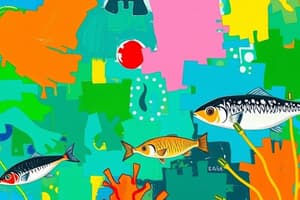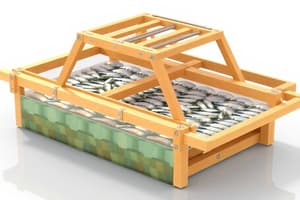Podcast
Questions and Answers
What percentage of the total aquaculture production in the Philippines is comprised of seaweeds?
What percentage of the total aquaculture production in the Philippines is comprised of seaweeds?
- 65.60% (correct)
- 18.51%
- 11.79%
- 3.15%
Which of the following regions is the largest producer of milkfish in the Philippines?
Which of the following regions is the largest producer of milkfish in the Philippines?
- Central Luzon (correct)
- CALABARZON
- Ilocos Region
- Western Visayas
What is the main species of shrimp produced in the Philippines?
What is the main species of shrimp produced in the Philippines?
- Vannamei (correct)
- P.monodon
- Shrimps/Prawns
- P. japonicus
Where do the majority of shrimps produced in the Philippines go?
Where do the majority of shrimps produced in the Philippines go?
What type of aquaculture system is commonly used in the Philippines?
What type of aquaculture system is commonly used in the Philippines?
What percentage of Vannamei farms in the Philippines are used for semi-intensive and intensive culture?
What percentage of Vannamei farms in the Philippines are used for semi-intensive and intensive culture?
What is the total number of hectares of accredited grow-out Vannamei farms in the Philippines?
What is the total number of hectares of accredited grow-out Vannamei farms in the Philippines?
What species of fish is commonly cultured in ponds and tanks in the Philippines?
What species of fish is commonly cultured in ponds and tanks in the Philippines?
Which species is known for higher demand in eel farming?
Which species is known for higher demand in eel farming?
Which lake is associated with submerged cages?
Which lake is associated with submerged cages?
What are floating cages kept afloat by?
What are floating cages kept afloat by?
Which farming system involves high control and enclosed systems with filtration?
Which farming system involves high control and enclosed systems with filtration?
Which species is NOT commonly cultured in pens and cages?
Which species is NOT commonly cultured in pens and cages?
Which water body is associated with both Milkfish and Tilapia pen farming?
Which water body is associated with both Milkfish and Tilapia pen farming?
What is a significant advantage of the Extensive Approach to fish culture?
What is a significant advantage of the Extensive Approach to fish culture?
Which material is NOT used in constructing floating cage structures?
Which material is NOT used in constructing floating cage structures?
Which country has the largest contribution to global aquaculture production?
Which country has the largest contribution to global aquaculture production?
What is the most commonly cultured finfish species in the world?
What is the most commonly cultured finfish species in the world?
Which country is the largest producer of aquatic plants, including Eucheuma and Kappaphycus?
Which country is the largest producer of aquatic plants, including Eucheuma and Kappaphycus?
What percentage of the Philippine fisheries production comes from aquaculture?
What percentage of the Philippine fisheries production comes from aquaculture?
What is the dominant type of livelihood among registered fisherfolks in the Philippines?
What is the dominant type of livelihood among registered fisherfolks in the Philippines?
Which species of fish is commonly cultured in earthen ponds, concrete tanks, and pens in the Philippines?
Which species of fish is commonly cultured in earthen ponds, concrete tanks, and pens in the Philippines?
What is the ranking of the Philippines in terms of global production of aquatic plants?
What is the ranking of the Philippines in terms of global production of aquatic plants?
Which country is the second largest producer of tilapia in the world?
Which country is the second largest producer of tilapia in the world?
What is the main advantage of the 'River in a pond' IPRS production technology?
What is the main advantage of the 'River in a pond' IPRS production technology?
Which species is best suited for Biofloc Technology?
Which species is best suited for Biofloc Technology?
What is a characteristic of small pond intensive shrimp farming?
What is a characteristic of small pond intensive shrimp farming?
Which type of aquaculture is suitable for urban areas and involves a recirculating system?
Which type of aquaculture is suitable for urban areas and involves a recirculating system?
What is a common trend in the farming of crabs?
What is a common trend in the farming of crabs?
What are some major challenges faced by the aquaculture industry?
What are some major challenges faced by the aquaculture industry?
Which aquaculture technology was developed by UP Visayas?
Which aquaculture technology was developed by UP Visayas?
What is the stocking density used in small pond intensive shrimp farming grow-out ponds?
What is the stocking density used in small pond intensive shrimp farming grow-out ponds?
What is a key feature of the semi-intensive approach to aquaculture?
What is a key feature of the semi-intensive approach to aquaculture?
What is one advantage of using the intensive approach to aquaculture?
What is one advantage of using the intensive approach to aquaculture?
Which disadvantage is associated with the semi-intensive approach?
Which disadvantage is associated with the semi-intensive approach?
Which system is designed to filter, treat, and reuse water to increase operational efficiency?
Which system is designed to filter, treat, and reuse water to increase operational efficiency?
What distinguishes Generation 5 shrimp aquaculture from earlier generations?
What distinguishes Generation 5 shrimp aquaculture from earlier generations?
Which species are fit for Recirculating Aquaculture Systems (RAS)?
Which species are fit for Recirculating Aquaculture Systems (RAS)?
What is a feature of the Intensive Approach in aquaculture?
What is a feature of the Intensive Approach in aquaculture?
What is a characteristic of Generation 4 shrimp aquaculture?
What is a characteristic of Generation 4 shrimp aquaculture?
Flashcards are hidden until you start studying



